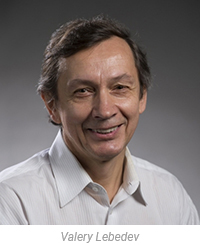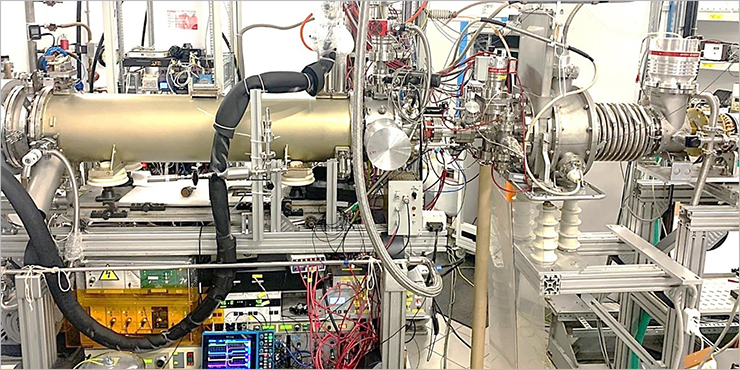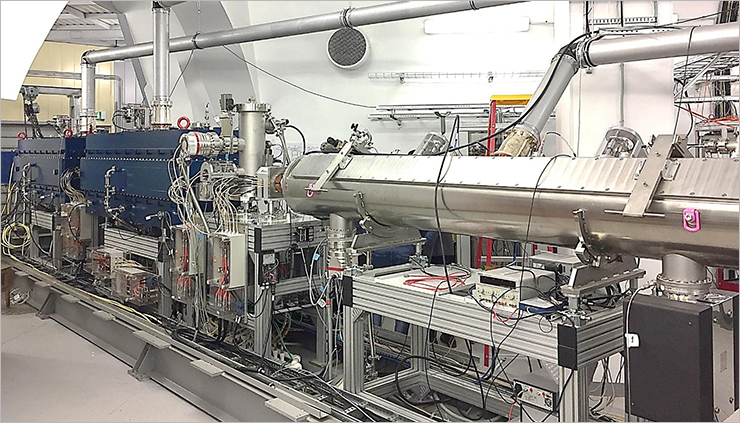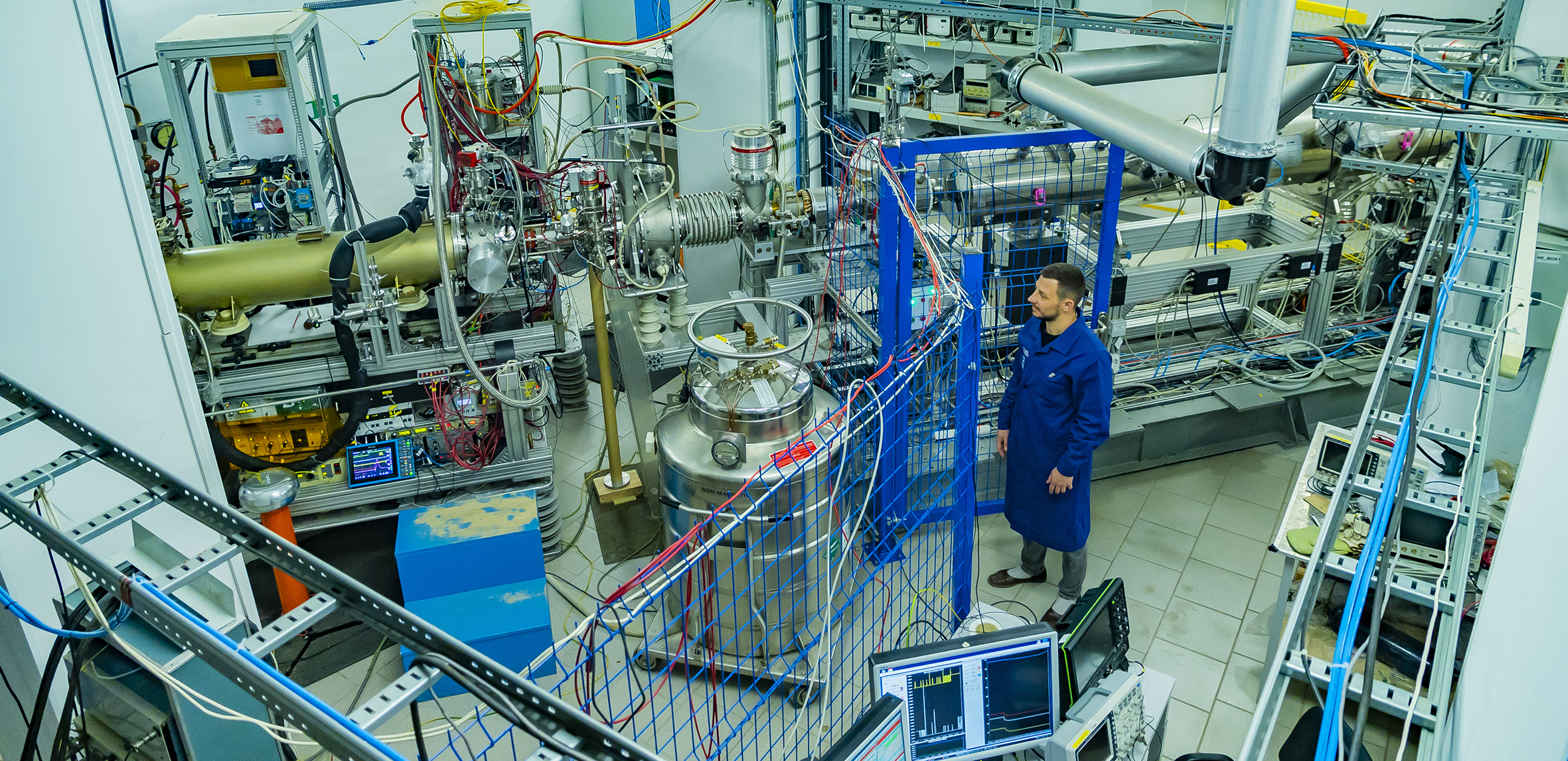In anticipation of NICA launch: injection complex development and personnel training
Interview, 28 March 2024
The construction of the NICA collider is ongoing Laboratory of High Energy Physics at JINR. The aim of the work is to achieve the injection of the beam into the collider rings late this year or early in next year. In parallel, the development of the collider’s injection complex and construction of new stations for applied research with Nuclotron extracted beams are carried out. And also, importantly, training is being organized for operators who will operate the accelerator complex in the future. The training will significantly reduce the number of employees required to maintain the operation of the accelerator-storage complex, which will free up resources for its further development.
Valery Lebedev, Deputy Head of the VBLHEP Accelerator Division for scientific work, spoke about the state and progress with the development of the NICA injection complex in an interview with the JINR Press Office.
— Valery Anatolievich, please tell us what results were achieved during the last session at NICA and what large-scale tasks are now facing the injection complex team?
 — From October 2023 to early February 2024, we conducted the 4th commissioning run of the NICA injection complex. It allowed us to test and put into operation all the systems of the complex that were planned to be included. In addition to adjusting and optimizing the accelerator, we also delivered ions for the BM@N experiment, which allowed it to collect statistics, although less than promised, but a record for heavy ions and sufficient to obtain new physics results. More than half a billion events were recorded. Technically, the run was successful, but now for the collider to work successfully, we need to increase the productivity of the injection complex at least 50 times, but rather 100 times in comparison with the intensity achieved in the 4th run. I would say that our main achievement in the fourth run was the formulation of goals and objectives for further work. The intensity of the injection complex is to be increased, firstly, by the accumulation of ions during the injection into the Booster using electronic cooling and, secondly, by reducing losses during the acceleration of ions and their transfer between accelerators.
— From October 2023 to early February 2024, we conducted the 4th commissioning run of the NICA injection complex. It allowed us to test and put into operation all the systems of the complex that were planned to be included. In addition to adjusting and optimizing the accelerator, we also delivered ions for the BM@N experiment, which allowed it to collect statistics, although less than promised, but a record for heavy ions and sufficient to obtain new physics results. More than half a billion events were recorded. Technically, the run was successful, but now for the collider to work successfully, we need to increase the productivity of the injection complex at least 50 times, but rather 100 times in comparison with the intensity achieved in the 4th run. I would say that our main achievement in the fourth run was the formulation of goals and objectives for further work. The intensity of the injection complex is to be increased, firstly, by the accumulation of ions during the injection into the Booster using electronic cooling and, secondly, by reducing losses during the acceleration of ions and their transfer between accelerators.
In the last commissioning run at the NICA injection complex, the electron beam ion source KRION-6T showed stable operation, but nevertheless didn’t reach the intensity expected of it when its construction began a long time ago. The lack of ion intensity in the ion source will be compensated using the electron cooling unit, which has already demonstrated successful operation in the Booster and will allow beam accumulation. It is expected that we can accumulate about 10 injections in the Booster, which will take about 1 second and will increase the duration of the acceleration cycle from 4.5 to 5.5 seconds. Thus, the period will be extended slightly, but the intensity will increase ~10 times and reach the maximum value that the Booster can “digest”.
 KRION-6T (left) and the beginning of the heavy ion linear accelerator (right)
KRION-6T (left) and the beginning of the heavy ion linear accelerator (right)
The remaining factor of ~10 should be obtained using the loss minimization mentioned above. To minimize losses, we need to solve several problems, of which I will list the three main ones now. First, to correct the orbit so that the beam always moves in the center of the vacuum chamber. Second, to increase the energy of transferring from the Booster to the Nuclotron, which will increase both the efficiency of bypass and the efficiency of stripping ions – to “bare” nuclei. And third, to construct an optimal dependence of the field rise rate on time in order to eliminate beam losses associated with insufficient voltage of the accelerating resonators. In other words, the rate of rise of the guiding magnetic field must take into account the limitations of the RF system. This applies to both the Booster and the Nuclotron. We expect these measures to reduce losses from around 90-95% to less than 50%. I note that of this 50%, about half are related to the stripping process. A further reduction in stripping losses would require a significant increase in the energy of the Booster, that is, the new Booster; but we can fight for the remaining half in the future.
— What tasks, in addition to the MPD experiment itself, will require such statistics of collected events?
— Let me note that in the latest commissioning run we adjusted the speed of slow beam extraction to the maximum that the BM@N experiment could use. A further increase in intensity led to temporary overlap of events and loss of information. In this case, the maximum intensity that the accelerator could provide was only slightly higher than the intensity that the detector could receive. If in the future we increase the efficiency of the injection complex by two orders of magnitude, this will open up new opportunities and pose new challenges for the experiments located in Building 205 of VBLHEP. If in the future there are a hundred times more particles, then the possibility of a new class of experiments will open up, in which the beam intensity will be much higher. Our pressing task is to formulate a strong and modern program corresponding to the world level.
The collider will use only 10–20% of the operating time of the injection complex. It means that during the remaining time the injection complex can be used for the experiments in Building 205. Unlike the collider, which will use fast single-turn extraction from the Nuclotron, these experiments will use slow extraction. To maximize the use of the injection complex, we need to have at least one more ion source to inject the beam into the Booster. This will allow two different types of ions to be used simultaneously and switching from one type to the other should take less than a minute. This can be either a laser source, which works well with ions of average mass, or a source with electron cyclotron resonance, which will produce intense beams of highly charged ions. The presence of two sources will make it possible to supply different types of ions not only to the collider and BM@N, but also to a range of experiments in Building 205, which will be conducted almost simultaneously.
 Heavy ion linear accelerator (HILAC)
Heavy ion linear accelerator (HILAC)
— Have ideas for such scientific tasks already been outlined?
— Scientific Leader of the Laboratory of Nuclear Reactions at JINR, RAS Academician Yuri Tsolakovich Oganessian put forward a proposal to conduct a series of experiments at NICA, complementing the FLNR experiments, but carried out at a much higher energy, up to 500 MeV/nucleon. In particular, we are examining the possibility of obtaining and detecting helium-12 nuclei, which have not yet been observed, but, from certain considerations, may exist. We don’t know yet whether helium-12 can exist; it is proposed to test this in an experiment. This experiment requires a different ion source than the collider does. This highlights the need to have a second ion source on the linac for heavy ions. The details of the experiment and the target station still require further elaboration.
I would also like to mention that in addition to the MPD detector, the NICA collider will have the SPD detector, which will begin operation several years later than the MPD. Currently, VBLHEP has good expertise in producing polarized hydrogen and deuterium nuclei. Our urgent task is to develop both the expertise and experimental base for working with light polarized nuclei, and the corresponding physics program. Currently, VBLHEP has good expertise in producing polarized hydrogen and deuterium nuclei. Our urgent task is to develop both the expertise and experimental base for working with light polarized nuclei, and the corresponding physics program. Although work with heavy nuclei is undoubtedly a top priority, we should never forget about the development of a polarization program. Now I will just note that the discussion of these tasks is the subject of another interview.
— Could changes be required in the organisational structure of the accelerator complex?
— During the four commissioning runs carried out at the NICA injection complex, most of the team of the VBLHEP Accelerator Division worked in shifts. Each department was responsible for the operability of its equipment. As a result, more than 20 people were involved in each 12-hour shift. This significantly slowed down all other activities of the Division. Launching two collider rings will increase the amount of equipment significantly. Accordingly, maintaining the same work style would require a number of people needed to operate the facility that would exceed the number of personnel in the Division. In addition, the collider operation implies its year-round operation with a break of 2-3 months for equipment repairs and upgrade/development. Meanwhile, world experience shows that even a larger accelerator complex can be managed by a shift of 4-5 highly qualified employees. Therefore, now, in order to optimize the work of the Division personnel, it is planned to establish a separate unit from among specially trained personnel. In total, about 20 people will service the accelerator complex in shifts of 8 hours, not 12; about 10 more people will operate the cryogenic system in shifts. At the same time, most of the challenging work on setting up the collider and repairing its systems, will be carried out by the units responsible for these systems, as it is done now. The transition to this new work style will take a long time – about a year – and will be quite painful; but in the future this will significantly increase our efficiency.
In the autumn of 2023, the Accelerator Division staff prepared and delivered a course for initial training of accelerator complex operators. The course comprises 22 lectures, which main aim was to show how the accelerator complex is maintained and operates nowadays. The presented material did not require deep knowledge of accelerator physics and was aimed precisely at the knowledge that operators need. The number of employees attending the lectures significantly exceeded the number of operators we need. We see this as a very good response from the personnel to the future challenges that we will see once the collider is put into operation. Further operator training will be carried out at the workplace. The first five people have already become involved in this process and are mastering control of the ion source and linac (HILAC). In future, as the facility is put into operation, we will involve other employees who want to work as operators. I invite everyone interested to contact me or Anatoly Olegovich Sidorin for this purpose. Operating an accelerator complex requires a lot of specific knowledge, and this cannot be achieved without instructions developed and tested at the workplace. In this regard, those responsible for different zones of the accelerator complex need to elaborate instructions for setting up and maintaining the operation of the equipment in their control. This is a rather lengthy task because each instruction must be tested in practice by future NICA operators. I repeat, we chose the audience for our lectures to be as wide as possible so that all interested employees could attend, even those who do not intend to be operators. The main goal of the training is to make the team complementary, working harmoniously, amicably and effectively.

